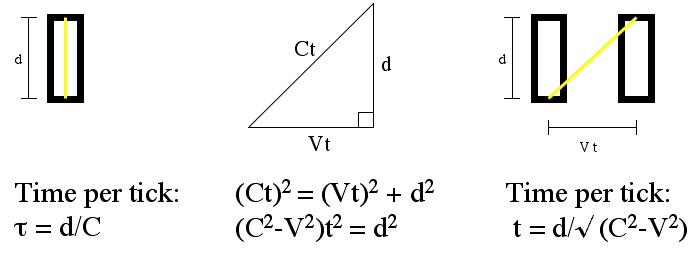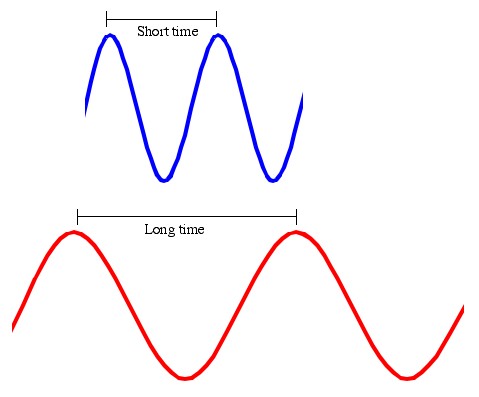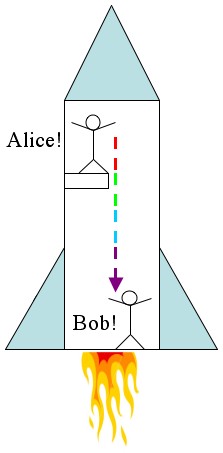Physicist: Back in the day, Galileo came up with the “Galilean Equivalence Principle” (GEP) which states that all the laws of physics work exactly the same, regardless of how fast you’re moving, or indeed whether or not you’re moving. (Acceleration is a different story. Acceleration screws everything up.) What Einstein did was to tenaciously hold onto the GEP, regardless of what common sense and everyone around told him. It turns out that the speed of light can be derived from a study of physical laws. But if physics is the same for everybody, then the speed of light (hereafter “C”) must be the same for everybody. The new principle, that the laws of physics are independent of velocity and that C is the same for everybody, is called the Einstein Equivalence Principle (EEP).
Moving faster makes time slow down: I’ve found that the best way to understand this is to actually do the calculation, then sit back and think about it. Now, if a relativistic argument doesn’t hinge on the invariance of C, then it isn’t relativistic. So ask yourself “What do the speed of light and time have to do with each other?”. A good way to explore the connection is a “light clock”. A light clock is a pair of mirrors, a fixed distance apart, that bounce a photon back and forth and *clicks* at every bounce. What follows is essentially the exact thought experiment that Einstein proposed to derive how time is affected by movement.

The proper time "τ" is how long it takes for the clock to tick if you're moving with it. The world time "t" is the time it takes for the clock to tick if you're moving with a relative velocity of V.
Let’s say Alice is holding a light clock, and Bob is watching her run by, while holding it, with speed V. Alice is standing still (according to Alice), and the time, , between ticks is easy to figure out: it’s just
. From Bob’s perspective the photon in the clock doesn’t just travel up and down, it must also travel sideways, to keep up with Alice. The additional sideways motion means that the photon has to cover a greater distance, and since it travels at a fixed speed (EEP y’all!) it must take more time. The exact amount of time can be figured out by thinking about the distances involved. Mix in a pinch of Pythagoras and Boom!: the time between ticks for Bob. So Bob sees Alice’s clock ticking slower than Alice does. You can easily reverse this experiment (just give Bob a clock), and you’ll see that Alice sees Bob’s clock running slow in exactly the same way.
It turns out that the really useful quantity here is the ratio: . This equation is called “gamma”. It’s so important in relativity I’ll say it again:
.
It may seem at first glance that the different measurements are an illusion of some kind, like things in the distance looking smaller and slower, but unfortunately that’s not the case. For Alice the light definitely travels a shorter distance, and the clock ticks faster. For Bob the light really does travel a greater distance, and the clock ticks slower. If you’re wondering why there’s no paradox, or want more details, then find yourself a book on relativity. There are plenty. Or look up Lorentz boosts. (The very short answer is that position is also important.)
The lower the slower: Less commonly known, is that the lower you are in a gravity well, the slower time passes. So someone on a mountain will age (very, very slightly) faster than someone in a valley. This falls into the realm of general relativity, and the derivation is substantially more difficult. Einstein crapped out special relativity in a few months, but it took him another 10 years to get general relativity figured out. Here’s a good way to picture why (but not quite derive how) acceleration causes nearby points to experience time differently:
Alice and Bob (again) are sitting at opposite ends of an accelerating rocket (that is to say; the rocket is on, so they’re speeding up). Alice is sitting at the Apex (top) of the rocket and she’s shining a red light toward Bob at the Bottom of the rocket. It takes some time (not much) for the light to get from the Apex of the rocket to the Bottom. In that time Bob has had a chance to speed up a little, so by the time the light gets to him it will be a little bit blue-shifted. Again, Alice sees red light at the Apex and Bob sees blue light at the Bottom.

Counting the blue crests is faster than counting the red crests. However, since it's all the same light beam the number of crests has to be the same to everybody.
The time between wave crests for Bob are short, the time between wave crests for Alice are long. Say for example that the blueshift increases the frequency by a factor of two, and Alice counts 10 crests per second. Then Bob will count 20 crests per second (No new crests are being added in between the top and the bottom of the rocket). Therefore, 2 seconds of Alice’s time happens in 1 second of Bob’s time. Alice is moving through time faster.
Einstein’s insight (a way bigger jump than the EEP) was that gravitational acceleration and inertial acceleration are one and the same. So the acceleration that pushes you down in a rocket does all the same things that the acceleration due to gravity does. There’s no way to tell if the rocket is on and you’re flying through space, or if the rocket is off and you’re still on the launch pad.
It’s worth mentioning that the first time you read this it should be very difficult to understand. Relativity = mind bending.








David Says
“so we basically wouldn’t have to reach 300 000,rather find a direction to which to go in order to maximize our speed relative to the stillness in space which is 0 km/h? ”
That is a question I have been been wrestling with some time David. What if we just stopped how fast would time go? If we stopped in some point in space relative to all other things in the universe then there must be a nominal speed of time for us compared to someone traveling at close to the speed at of light?
Or is it that space is expanding around us and therefore it is impossible to stop?
My Brain is hurting now
@Jamie Miller
You’re always sitting still with respect to yourself and you’re always moving through time at the maximum possible rate according to your own clock. Relativity is called “relativity” because the only kind of velocity that matters is velocity relative to something else.
The big idea to keep in mind is that every individual thing in the universe has its own clock and time dilation is all about how those clocks relate to each other. But the universe itself does not have a clock. There’s no “true clock” to compare against.
“the only kind of velocity that matters is velocity relative to something else.”
This is a very subjective statement for a physicist. Whether or not velocity matters or not is of no matter. I suspect what is meant is that the only velocity that can be observed is velocity relative to something else and that this relative velocity has no meaning in spacetime.
UNLESS, the relative velocity is observed relative to a photon. However, there is no absolute method of measuring the velocity of a passing photon since your unknown spacetime velocity affects the observation and any observation method you use will return the same velocity c independent of your own unknown (but very real) velocity.
Hi. I have a question,and than I will have a follow up question after this one. If person A from Earth starts traveling at a speed close to c towards a far away planet,lets say 1 light year away, is it possible that I ,person B, would reach that planet faster by moving at a certain speed that is slower than his?…or maybe arrive at the same time?
@David
Not unless you have a head start. Relativity says a lot of weird things about the nature of space and time, but at the end of the day: faster is faster.
A follow up comment on the light clock. One if Einstinen’s two postulates which are the basis for his theory of relativity is that lights always propagated in space at a speed of c independently of the speed of the emitting source. In effect the two mirrors in the light clock are emitting sources. As a result the photon will not follow the saw tooth path implied above. The photon will bounce back and forward between the two mirrors with no forward motion until the mirrors pass by and the photon will fall off the edge.
Ok. Thought so. No for my second question. Person A is on the end of the hand of a clock. A big clock. I mean huge. The hand is moving close to c at the point where person A is sitting. Person B is also on the hand right near the center. He is moving slow. I dont know the math and how much slower than the tip of the hand so I say slow. The hand will start moving from 12 in a circular motion, as clocks do. There are 2 triggers on the field. One trigger, trigger A, is on one minute to 3. Or 12:14.It is aligned that the hand where person A is,, touches it. When he does, the hand will come to a full stop. The second trigger, B, is near the center but on 12:15. It is also on person B s trajectory. When person B comes to tB the hand will snap. What would happen. Will person A see a swirel of person B moving ahead of him? If he had a monitor which transmitted image faster than light, would he see the future that will never happen? Would he see the hand snap before coming to a full stop, hands unsnapped?Or even worse, would he see person B ahead of him waiting for him at the 14th minute because that is the future place that awaits person A after the stop and person B is doing what he would have been doing waiting.Meanning that there are information moving faster than light because the mechanism must know ahead of time that the hand will never snap???I hope you understand my question, I haven’t really asked it well but please brainstorm a little around this question.If not, what would happen? what would each person see? It doesn’t have to be a clock. It can be person A orbiting Earth from far away, person B is on Earth.and the B trigger is that something else happens…But they are aligned and person As trigger is first.
This comment is me thinking “out loud”. Einstein’s brilliance was his way to think about the world and use the creative visualization to create possibilities in his mind and merge that with his rational mind to convert that to experiments and equations.
But Einstein was human and all humans have bias.
We can evaluate Einstein’s bias by the things he said and the aim he proportedly has.
Einstein was driven by wanting to create an equation no more than an inch in length that described everything and effectively understand God by this equation.
As part of this bias, simplicity was required. Time/space had to be viewed as the same thing. That doesn’t make him wrong; it means he chose to describe a description To its most simple components.
Although time/space is viewed as one, you can take any expression as time space and if you can describe how one converts to the other you can plug those into Einstein’s equations.
Einstein said “time is an illusion, albeit a very persistent one”
The problem is speed of light is traditionally viewed as space traveled over time. Einstein has to rectify this by comparing it to mass and energy.
We could sub in these equations the way in high school most learned the F(x) function if his equations have a variable describing space/time, or rewrite these equations with different understanding.
What if time is not an illusion but motion is? It would still fit the Einstein model effectively but would require a new way to write the same principal of relativity. We can evoke Xeno’s paradox and the philosophy that there is an infinite number of half way points and so experience is all mental. The speed of light can not be understood as a constant but instead this is a limiting mechanism of perception rather then a property in a physical space actually moving. Relativity then in this model becomes the dominant trait, how things appear relative to each other and psychology determines we understand reality comparing one thing relative to another. All math equations require variables doing something compared to another even though in nature you never have one plus one but oneX plus oneX l. You can add one of something with properties to another something with properties. If those things are humans that mate and produce a 3rd, then the equation doesn’t represent reality unless X contains a multiplier.
But even in the production of a child we understand the principals of multiplication and addition and the ability to form life from something that didn’t previously exist in that form.
If the speed of light is not actually moving then it makes more sense why someone traveling nearly the speed of light will still view the speed of light as a constant speed moving the same rate relative to themselves away from themselves. That is a function of the perceiver/observer being different which may better mesh with quantum mechanics since there is an observer effect.! The observer doesn’t necessarily need time to be an illusion of motion is the illusion. If motion is the illusion then the mind can reproduce it no matter what “speed” it’s moving since it isn’t ever really moving it only is changing ratios of variables compared to each other the same way a cartoon on a page gets smaller as it approaches the horizon line to simulate distance our brain can do that to our experience to simulate relativistic experiences and the ratios and harmony of the universe is in how things compare relative to each other in appearance.
If motion is the illusion space is mental and in the mind and speed is the illusion of motion over time. The speed of light is proportional to the limits of our illusion and beyond that limit exists a higher dimension we are not able to perceive from within these limits of the mind.
So if motion is an illusion, Time can be explored but it’s hard to think about time without having it relative to something else. Relative to relativity itself? Time relative to perception? If all things are relative we can view time as a constant the same way we can model the earth or the sun as a stationary object and see how the others move relative to it even though relative to the universe the sun is expanding with it while rotating around the galactical center so we can come up with different orbital paths of the sun relative to motion if motion is real. Motion is observer as distance over time but if time is false then motion becomes an illusion anyways and the problem breaks down again. If time is real, motion can still be an illusion and equal perception over time or relative awareness of the relationship of two things over time.
I think it more likely space is the illusion and if so motion doesn’t really exist and the form of everything is oneness, but then relativity is only how the mind interprets reality, how the mental processes the “physical”.
I’m stuck so it’s time to reframe the problem….
Time is the wave function or frequency. So maybe everything is frequency. You can look at how much something does something per unit of time in the classical sense of frequency or you can hear it and feel it as a sensory experience.
Then it’s still how frequent the sound hits your eardrum as we understand it. But still there is something different about harmony of music that isn’t perceived as relating to motion and how frequently something occurs. It’s more qualitative then that. The experience doesn’t match the more observational and it’s more of a resonance vibration that seems to have the power to make time move non linearly with the frequency as the only constant. There must be a different way to understand reality leveraging the genius of Einstein and looking at the problem in a different way.
What if time moves relative to frequency. Rather than frequency moving relative to time…
That would functionally look the same way but it would present time as non linear and allow us to examine movement and sound and frequency and anything as something affecting time and giving the appearance of movement. Relativity becomes more about harmony and disharmony of time and observers then.
Speed of Starlight
A glass cube is floating horizontally in outer space. Two rays of starlight coming from the left and right are passing through the glass horizontally. Below is the difference between the two rays of light as seen from viewpoint of the glass (difference in formula v = f λ).
Difference inside the glass c/n = c/n f ≠ f λ ≠ λ
Difference just before entering the glass c ≠ c f ≠ f λ = λ
Difference just after leaving the glass c = c f ≠ f λ ≠ λ